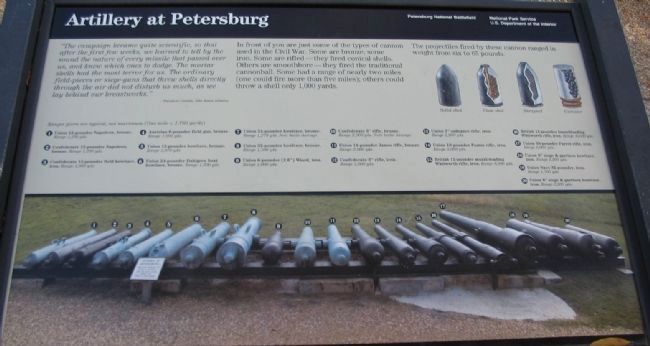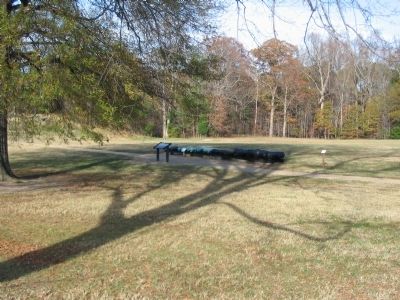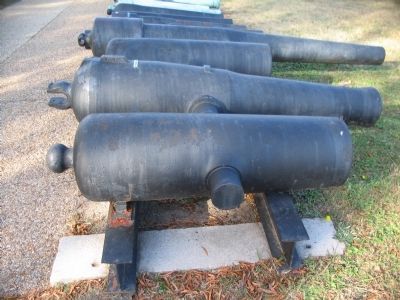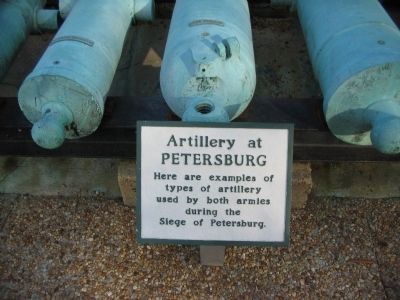Near Prince George in Prince George County, Virginia — The American South (Mid-Atlantic)
Artillery at Petersburg
Theodore Gerrish, 20th Maine Infantry
In front of you are just some of the types of cannon used in the Civil War. Some are bronze, some iron. Some are rifled - they fired conical shells. Others are smoothbore - they fired the traditional cannonball. Some had a range of nearly two miles (one could fire more than five miles); others could throw a shell only 1,000 yards.
The projectiles fired by these cannon ranged in weight from six to 65 pounds.
(Numbered tags to each cannon on display, referenced on the photograph):
Ranges given are typical, not maximum (one mile = 1,760 yards)
(1) Union 12-pounder Napoleon, bronze. Range 1,200 yds.
(2) Confederate 12-pounder Napoleon, bronze. Range 1,200 yards.
(3) Confederate 12-pounder field howitzer, iron. Range 1,000 yds.
(4) Austrian 6-pounder field gun, bronze. Range 1,000 yds.
(5) Union 12-pounder howitzer, bronze. Range 1,070 yds.
(6) Union 24-pounder Dahlgren boat howitzer, bronze. Range 1,300 yds.
(7) Union 24-pounder howitzer, bronze. Range 1,270 yds. Note battle damage.
(8) Union 32-pdr howitzer, bronze. Range 1,500 yds.
(9) Union 6-pdr (2.6") Wiard, iron. Range 1,000 yds.
(10) Confederate 3" rifle, bronze. Range 2,000 yds. Note battle damage.
(11) Union 14-pounder James rifle, bronze. Range 2,000 yds.
(12) Confederate 3" rifle, iron. Range 3,000 yds.
(13) Union 3" ordnance rifle, iron. Range 2,800 yds.
(14) Union 10-pounder Parrott rifle, iron. Range 3,200 yds.
(15) British 12-pounder muzzleloading Whitworth rifle, iron. Range 8000 yds.
(16) British 12-pounder breechloading Whitworth rifle, iron. Range 10,000 yds.
(17) Union 30-pounder Parrott Rifle, iron. Range 6,000 yds.
(18) Union 8" siege & garrison howitzer, iron. Range 2,200 yds.
(19) Union Navy 32-pounder, iron. Range 1,700 yds.
(20) Union 8" seige & garrison howitzer, iron. Range 2,200 yds.
Erected by National Park Service, U.S. Department of the Interior.
Topics. This historical marker is listed in this topic list: War, US Civil.
Location. 37° 14.673′ N, 77° 21.421′ W. Marker is near Prince George, Virginia, in Prince George County. Marker can be reached from Petersburg Tour Road, on the left when traveling north. Located along the Battery 5 walking tour, in Petersburg National Battlefield Park. Touch for map. Marker is at or near this postal address: 5001 Siege Rd, Prince George VA 23875, United States of America. Touch for directions.
Other nearby markers. At least 8 other markers are within walking distance of this marker. The Petersburg Campaign (here, next to this marker); Uprooted by War (within shouting distance of this marker); Battery 5 of the Dimmock Line (within shouting distance of this marker); Siege of Petersburg — Grant's First Offensive (within shouting distance of this marker); Battery 5 Trail (within shouting distance of this marker); The Siege of Petersburg (about 300 feet away, measured in a direct line); Prelude to Petersburg (about 300 feet away); Stephen Tyng Mather (about 300 feet away). Touch for a list and map of all markers in Prince George.
More about this marker. In the upper right are illustrations of solid shot, case shot, shrapnel, and canister rounds used by rifled guns. The lower half of the marker displays a photograph of the guns on display, keyed to the numbers in the text above.
Also see . . .
1. Battle and Siege of Petersburg. National Park Service site. (Submitted on December 22, 2008, by Craig Swain of Leesburg, Virginia.)
2. History of the Petersburg National Military Park
. (PDF) Detailed history of the park. In 1936 officials planned to develop an artillery exhibit at Petersburg. Since a wide variety of guns were used at the siege, Petersburg was a fitting place for such a display. By the start of World War II, over 100 pieces were acquired. But with the war came scrap drives. Officials at the park buried the guns to keep them from the melting pots. See page 95 of the PDF for more details. (Submitted on December 22, 2008, by Craig Swain of Leesburg, Virginia.)
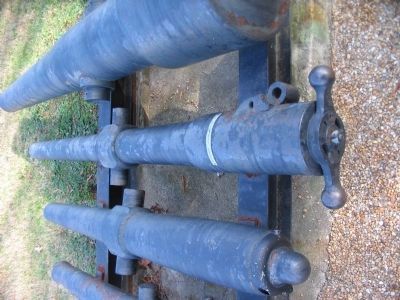
Photographed By Craig Swain, November 22, 2008
4. The Whitworth Guns
Tagged as numbers 15 and 16 on the captions, the two Whitworth guns are representative of the guns imported by both Federal and Confederate governments during the war. The pair also serves to illustrate the old technology used in the war (muzzle loading, at the bottom of this photo) with the new technology emerging at the time (breech loading, in the center). To the top of the frame is a 30-pounder Parrott Rifle.
Credits. This page was last revised on August 22, 2021. It was originally submitted on December 22, 2008, by Craig Swain of Leesburg, Virginia. This page has been viewed 1,906 times since then and 59 times this year. Photos: 1, 2, 3, 4, 5. submitted on December 22, 2008, by Craig Swain of Leesburg, Virginia.
